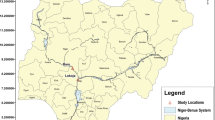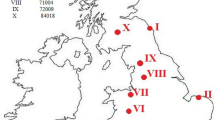Abstract
In the present study, an attempt is made to investigate and identify chaos using various techniques as well as river flow forecasting in short-term (daily) and mid-term (monthly) scales using nonlinear local approximation method (NLA) and ARIMA method. Daily and monthly flow data of Daintree River in Australia from 1969 to 2011 are used. In this respect, seven nonlinear dynamic methods including (1) average mutual information function; (2) phase space reconstruction; (3) false nearest neighbour algorithm; (4) method of surrogate data; (5) correlation dimension method; (6) Lyapunov exponent method; and (7) nonlinear local approximation are employed. The Takens’ theorem, mutual information and false nearest neighbour are used to determine the delay time and embedding dimension for the phase space reconstruction. The correlation dimensions obtained for the short term and mid-term river flow are 6.7 and 3.3, respectively. The finite dimensions obtained for the short term and mid-term river flow time series indicate the possible existence of chaos. The comparative analyses show that the NLA method is superior to ARIMA in mid-term scale while both models are acceptable for short term scale forecasting.






Similar content being viewed by others
References
Abrahart RJ, See L (2000) Comparing neural network and autoregressive moving average Techniques for the provision of continuous river flow forecasts in two contrasting catchments. Hydrol Process 14:2157–2172
Albostan A, Önöz B (2015) Implementation of chaotic analysis on river discharge time series. Energy Power Eng 7:81–92
Arunkumar R, Jothiprakash V (2013) Chaotic evolutionary algorithms for multi-reservoir optimization. Water Resour Manage 27:5207–5222
Box GEP, Jenkins GM, Reinsel GC (1994) Time series analysis forecasting and control, 3rd edn. Prentice- Hall, Englewood Cliffs
Casdagli M (1992) Chaos and deterministic versus stochastic non-linear modelling. J R Stat Soc Ser B Stat Methodol 54(2):303–328
Dhanya CT, Kumar DN (2010) Nonlinear ensemble prediction of chaotic daily rainfall. Adv Water Resour 33:327–347
Domenicoa MD, Ghorbani MA, Makarynskyy O, Makarynska D, Asadi H (2013) Chaos and reproduction in sea level. Appl Math Model 37:3687–3697
Elshorbagy E, Simonovic SP, Panu US (2002) Estimation of missing streamflow data using principles of chaos theory. J Hydrol 255:123–133
Grassberger P, Procaccia I (1983) Characterization of strange attractors. Phys Rev Lett 50(5):346–349
Hu Z, Zhang C, Luo G, Teng Z, Jia C (2013) Characterizing cross-scale chaotic behaviors of the runoff time series in an inland river of Central Asia. Quat Int 311(17):132–139
Jayawardena AW, Lai F (1994) Analysis and prediction of chaos in rainfall and streamflow time series. J Hydrol 153:23–52
Kantz H, Schreiber T (2004) Nonlinear time series analysis, 2nd edn. Cambridge University Press, Cambridge
Kennel MB, Brown R, Abarbanel HDI (1992) Determining embedding dimension for phase space reconstruction using a geometric method. Phys Rev A 45:3403–3411
Khan S, Ganguly AR, Saigal S (2005) Detection and predictive modeling of chaos in finite hydrological time series. Nonlinear Process Geophys 12:41–53
Khatibi R, Sivakumar B, Ghorbani MA, Kisi O, Kocak K, Farsadi Zadeh D (2012) Investigating chaos in river stage and discharge time series. J Hydrol 414–415:108–117
Kisi O, Moghaddam Nia A, Ghafari Gosheh M, Jamalizadeh Tajabadi MR, Ahmadi A (2012) Intermittent streamflow forecasting by using several data driven techniques. Water Resour Manag 26(2):457–474
Martins OY, Sadeeq MA, Ahaneku IE (2011) Nonlinear deterministic chaos in Benue River flow daily time sequence. J Water Resour Prot 3:747–757
Montanari A, Rosso R, Taqqu MS (2000) A seasonal fractional ARIMA model applied to the Nile River monthly flows at Aswan. Water Resour Res 36(5):1249–1259
Ng WW, Panu US, Lennox WC (2007) Chaos based analytical techniques for daily extreme hydrological observations. J Hydrol 342:17–41
Pasternack GB (1999) Does the river run wild? Assessing chaos in hydrological system. Adv Water Resour 23:253–260
Pramanik N, Panda RK, Sen D (2010) One dimensional hydrodynamic modeling of river flow using DEM extracted river cross-sections. Water Resour Manag 24(5):835–852
Rosenstein MT, Collins JJ, Deluca CJ (1993) A practical method for the calculating largest Lyapunov exponents from small datasets. Physica D 65:117–134
Savard CS (1992) Looking for chaos in streamflow with discharge derivative data. Eos Trans AGU (Spring Meeting Suppl) 73(14):50
Sivakumar B, Berndtsson R, Olsson J, Jinno K, Kavvamura A (2000) Dynamics of monthly rainfall-runoff process at the Gota basin: a search for chaos. Hydrol Earth Syst Sci 4(3):407–417
Sivakumar B, Berndtsson R, Persson M (2001) Monthly runoff prediction using phase space reconstruction. Hydrol Sci J 46(3):377–387
Sivakumar B, Jayawardena AW, Fernando TMKG (2002) River flow forecasting: use of phase-space reconstruction and artificial neural networks approaches. J Hydrol (1–4):225–245
Soofi A, Cao L (2002) Modelling and forecasting financial data techniques of nonlinear dynamics. Kluwer academic publisher, Norwell
Sukhodolov A, Jaroslaw J, Napiorkowski JJ, Rowinski PM (1996) Applicability of flow prediction based on attractors. Acta Geophys Pol 45(3):277–286
Takens F (1980) Detecting strange attractors in turbulence. Lect Notes Math 898:366–381
Theiler J, Eubank S, Longtin A, Galdikian B, Farmer JD (1992) Testing for nonlinearity in time series: the method of surrogate data. Physica D 58:77–94
Wang W-c, Chau K-w, Xu D-m, Chen X-Y (2015) Improving forecasting accuracy of annual runoff time series using ARIMA based on EEMD decomposition. Water Resour Manage 29:2655–2675
Wilcox BP, Seyfried MS, Matison TH (1991) Searching for chaotic dynamics in snowmelt runoff. Water Resour Res 27(6):1005–1010
Zhang Q, Wang B-D, He B, Peng Y, Ren M-L (2011) Singular spectrum analysis and ARIMA hybrid model for annual runoff forecasting. Water Resour Manag 25(11):2683–2703
Zhou Y, Ma Z, Wang L (2002) chaotic dynamics of the flood series in the Huaihe River Basin for the last 500 years. J Hydrol 258:100–110
Zounemat-Kermani M, Kisi O (2015) Time series analysis on marine wind-wave characteristics using chaos theory. Ocean Eng 100(15):46–53
Zounemat-Kermani M, Teshnehlab M (2008) Using adaptive neuro-fuzzy inference system for hydrological time series prediction. Appl Soft Comput 8(2):928–936
Zounemat-kermani M, Kisi O, Rajaee T (2013) Performance of radial basis and LM-feed forward artificial neural networks for predicting daily watershed runoff. Appl Soft Comput 13(12):4633–4644
Author information
Authors and Affiliations
Corresponding author
Rights and permissions
About this article
Cite this article
Zounemat-Kermani, M. Investigating Chaos and Nonlinear Forecasting in Short Term and Mid-term River Discharge. Water Resour Manage 30, 1851–1865 (2016). https://doi.org/10.1007/s11269-016-1258-1
Received:
Accepted:
Published:
Issue Date:
DOI: https://doi.org/10.1007/s11269-016-1258-1




